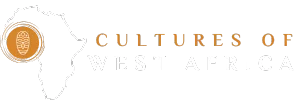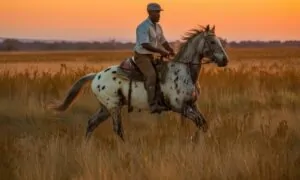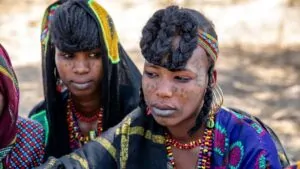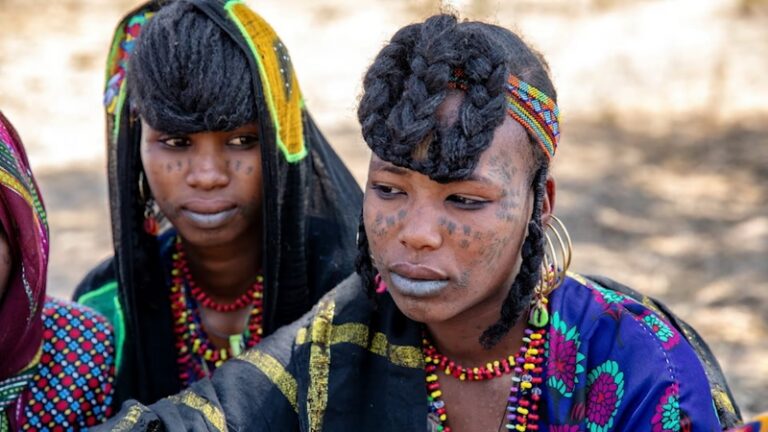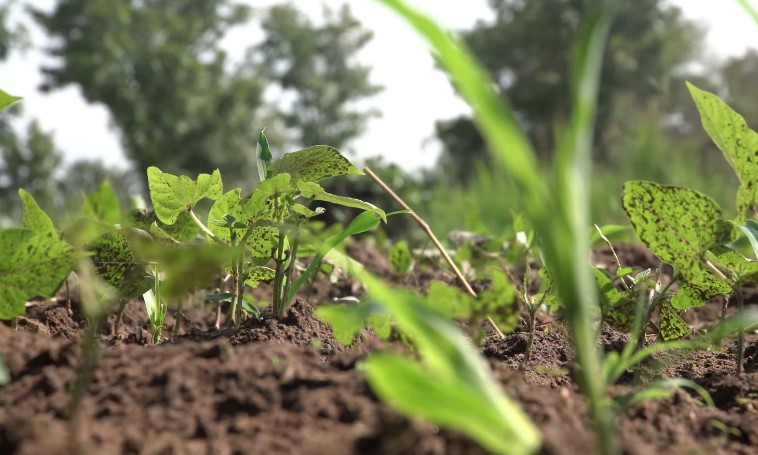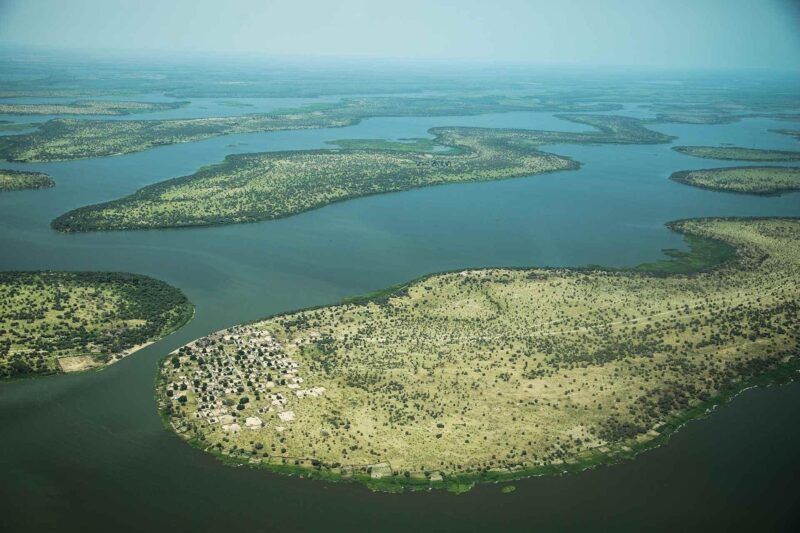
Lake Chad sits at the heart of Central Africa, stretching across the borders of:
Table of Contents
Toggle- Chad
- Nigeria
- Cameroon
- Niger
Once one of Africa’s largest freshwater bodies, it served as a vital artery for trade, agriculture, and culture.
Its shrinking size today mirrors the growing challenges faced by millions who depend on it for survival.
Travel opportunities, cultural heritage, and environmental restoration now define its modern narrative.
Let’s take a look at the Lake Chad basin and what we can expect from visiting this wonderful place.
The Geography and Ecology of Lake Chad

Once covering over 25,000 square kilometers, Lake Chad has experienced one of the most dramatic environmental transformations on the African continent, shrinking to less than 1,500 square kilometers.
Seasonal fluctuations define its changing boundaries, creating a mosaic of islands, marshes, and shallow channels that respond to rainfall and river inflow.
Each wet and dry season brings new ecological configurations, influencing both biodiversity and human activity.
Wetlands around the lake sustain a remarkable concentration of life. Over 350 bird species, including pelicans, herons, and migratory waterfowl, rely on its ecosystem for nesting and feeding.
The lake remains a vital stopover for birds migrating across the Sahara.
Fish populations such as tilapia, catfish, and carp continue to support countless fishing communities across:
- Chad
- Cameroon
- Nigeria
- Niger
Recognized as part of multiple Ramsar sites, Lake Chad holds international significance for conservation efforts.
Vegetation around the basin shapes both ecology and livelihood.
Grasses, papyrus, and acacia woodlands stabilize the soil, purify water, and mitigate the effects of desertification.
Natural vegetation performs several critical roles:
- Preventing soil erosion during rainy seasons.
- Providing fodder for pastoral herds and nesting materials for birds.
- Regulating microclimates and sustaining local rainfall patterns.
In recent years, researchers have intensified efforts to monitor hydrological cycles and identify sustainable solutions for water retention and restoration.
Lake Chad continues to influence regional climate patterns, functioning as an essential buffer against the encroaching Sahara.
Cultural Landscape and Human Settlement

For millennia, Lake Chad has served as a gathering point of cultures and civilizations.
Ethnic groups such as the Kotoko, Hausa, Barma, and Kanembu have built their social and economic structures around their shores.
Archaeological discoveries indicate Palaeolithic human presence, showing how early humans adapted to shifting water levels and seasonal abundance.
Ancient Sao civilization thrived in this area long before the rise of modern states, leaving behind terracotta sculptures, pottery, and fortified settlements that hint at advanced craftsmanship and social organization.
Communities living around Lake Chad have mastered the art of adaptation.
Livelihoods shift according to nature’s rhythm:
- Farmers cultivate millet and sorghum during wet months
- Fishers take to the waters during high tides
- Pastoralists migrate to greener areas during the dry season
Local economies depend on a cycle of cooperation and exchange.
Traditional markets form economic lifelines for border communities.
Goods commonly traded include:
- Salt and dried fish were exchanged between fishermen and inland traders.
- Grains and vegetables are transported through traditional trade routes.
- Livestock and leather products are sold to regional markets.
Social systems remain anchored in traditional governance and oral traditions.
Elders preserve historical memory, mediating disputes and ensuring that cultural values survive through:
- Storytelling
- Rituals
- Communal gatherings
Tourism and Travel Potential

Lake Chad offers immense potential for sustainable tourism due to its cultural wealth and ecological value.
Visitors encounter open horizons, shifting waters, and diverse wildlife that capture the essence of Central Africa’s environmental beauty.
Cross-border festivals and cultural gatherings celebrate the shared identity of neighboring nations through music, traditional dance, and artisanal crafts.
Tourism opportunities continue to grow, particularly in areas emphasizing ecotourism and cultural experiences.
Key attractions include:
- Bird-watching excursions featuring migratory and endemic species.
- Guided fishing tours led by local cooperatives.
- Visits to archaeological remains of the Sao civilization.
- Community craft centers produce handwoven mats, pottery, and leather goods.
Challenges remain evident. Security issues, limited road access, and poor infrastructure have slowed tourism development.
Regional initiatives are working to improve these conditions by:
- Promoting cooperation
- Supporting local entrepreneurship
- Enhancing safety measures
Governments and NGOs also invest in environmental mapping to protect fragile habitats while creating opportunities for responsible travel.
With continued collaboration, Lake Chad could emerge as a model for cross-border ecotourism and cultural exchange.
The Decline of Lake Chad
Decades of climate change and human intervention have reshaped Lake Chad’s physical and social reality.
Irregular rainfall, rising temperatures, and drought cycles have dramatically reduced river inflow.
Expanding irrigation projects, deforestation, and unsustainable land use compound the crisis.
Since the 1960s, the lake has lost around 90% of its surface area, transforming once-fertile plains into dry, dusty expanses.
Consequences reach far into daily life. Agricultural communities face declining crop yields, while fishing families struggle with depleting stocks.
Herdsmen travel longer distances to find pastures, often leading to tensions with farmers.
Rural displacement has become widespread as people migrate toward cities or neighboring countries in search of survival.
Social inequalities widen as women and youth bear the brunt of economic instability.
Key effects include:
- Loss of livelihoods in farming, fishing, and herding sectors.
- Increased poverty and food insecurity across the basin.
- Rising conflicts over water, land, and grazing routes.
- Ecological degradation and reduction of biodiversity.
Environmental restoration projects in the Lake Chad Basin focus on reforestation, sustainable water management, and soil recovery.
While large-scale revival efforts require regional coordination and hydrological interventions, localized tools, such as those offered by Admiral lake equipment, can support small communities in managing shoreline debris, enhancing water aeration in stagnant zones, and maintaining healthier micro-ecosystems.
Regional collaboration remains vital for reversing damage and securing sustainable livelihoods for millions who depend on the lake.
Conflict and Insecurity in the Lake Chad Basin

Armed conflicts have become intertwined with the lake’s environmental decline.
Groups such as Boko Haram exploit economic despair and resource scarcity to gain footholds in affected regions.
Communities already weakened by drought and displacement become easy targets for recruitment and intimidation.
As violence spreads, education and healthcare services collapse, and trade routes are disrupted.
Scarcity of water and arable land fuels tension between:
- Farmers
- Herders
- Fishermen
Traditional systems that once mediated disputes now struggle under modern pressures.
Sustainable peace in the Lake Chad Basin depends on addressing both security and environmental challenges together.
Final Thoughts
Regional cooperation is vital for the revival of Lake Chad.
Each effort, from reforestation to community education, contributes to a broader vision of renewal.
Awareness, solidarity, and responsible management can ensure the lake’s restoration.
With continued research, the use of the proper equipment, and international support, Lake Chad can once again become a thriving source of life for millions across Africa’s heartland.
Related Posts:
- Complete Wildlife Travel Guide to Yankari National…
- Exploring Africa Through Pictures - A Fun Learning…
- Mauritania vs Morocco - Which Country Is Better for…
- The Fulani People – History, Culture, and Tradition
- 10 Facts About the Hausa People and Their Culture
- 8 Fascinating Facts About West African Culture

